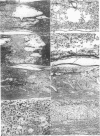Abstract
Controlled compressive injury to rat spinal cord was chosen to test therapies that might attenuate the progression of tissue destruction and locomotor deficits that characteristically occur after spinal injury. A highly significant reduction of damage was achieved by immediate postinjury treatment with a combination of the following: an antiinflammatory substance, indomethacin; a stimulator of cytokine secretion, bacterial lipopolysaccharide; and the parent steroid, from which all other steroids arise, pregnenolone. This treatment reduced histopathological changes, spared tissue from secondary injury, and increased restoration of motor function. Remarkably, 11 of 16 of the animals treated with the above combination were able to stand and walk at 21 days after injury, 4 of them almost normally. The results were far superior to those obtained in controls or in animals to which the substances were given separately or in combination of two. This approach may prove to be applicable to nervous system injury, in general, and to injury in other tissues.
Full text
PDF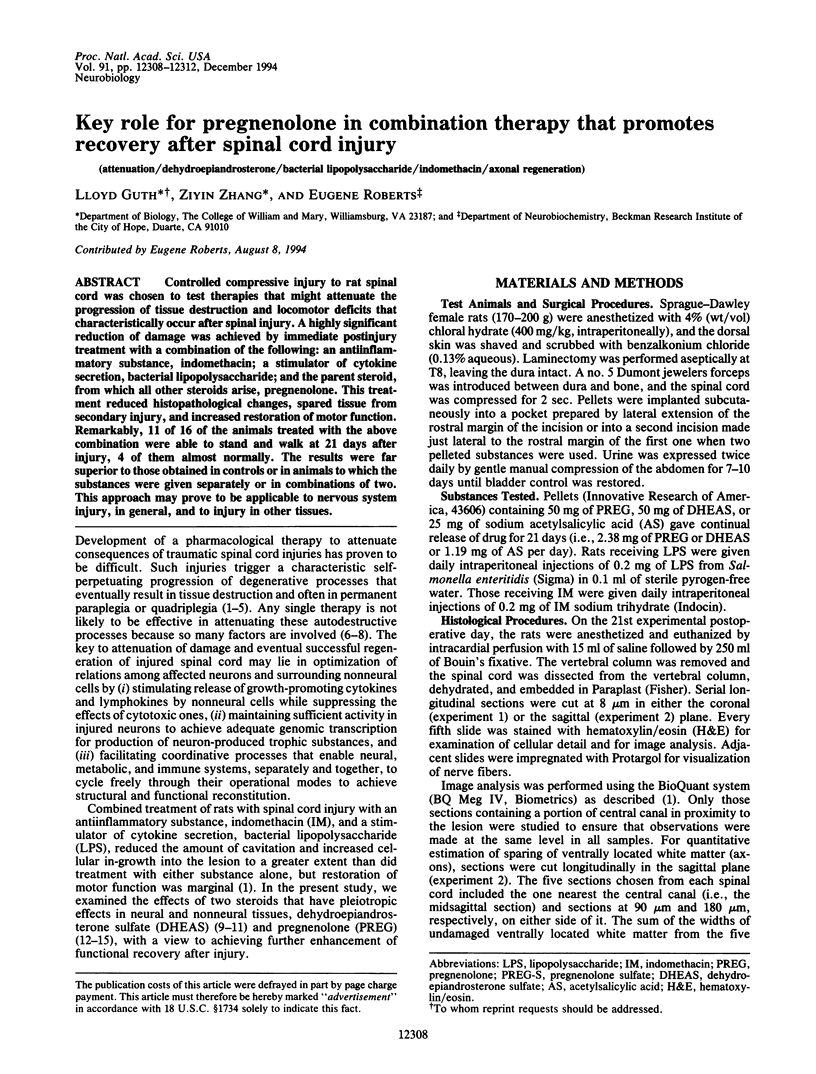
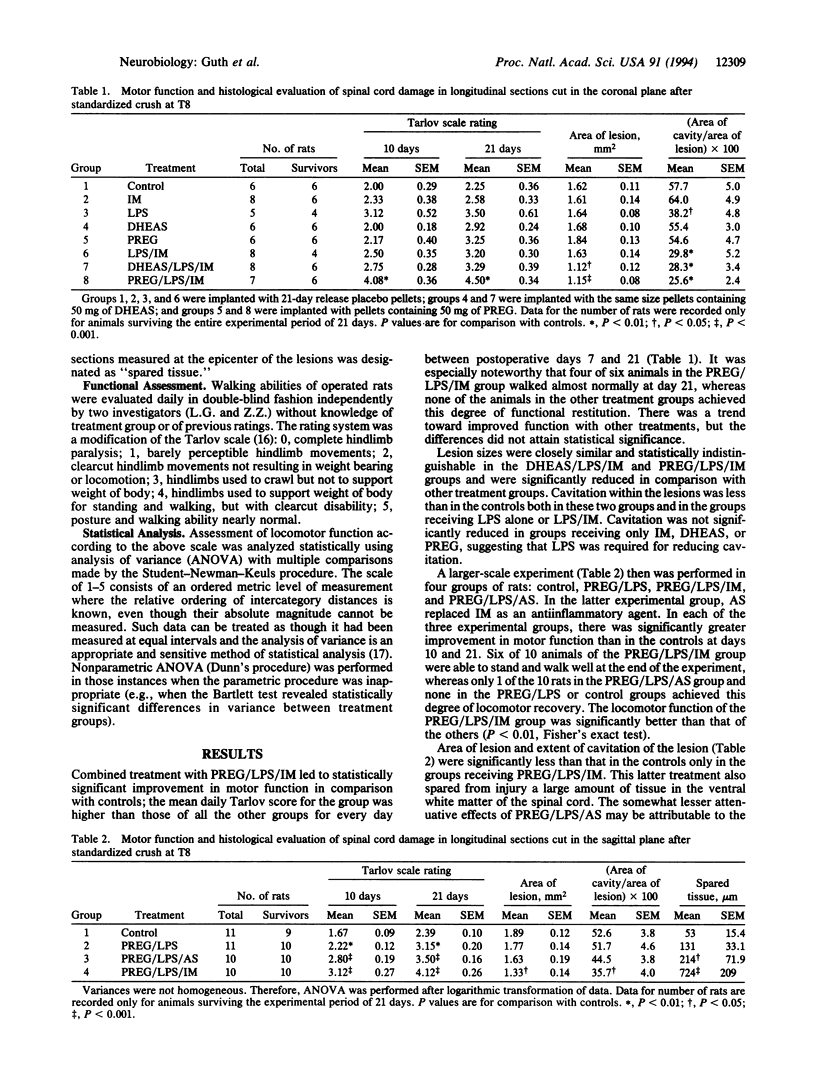
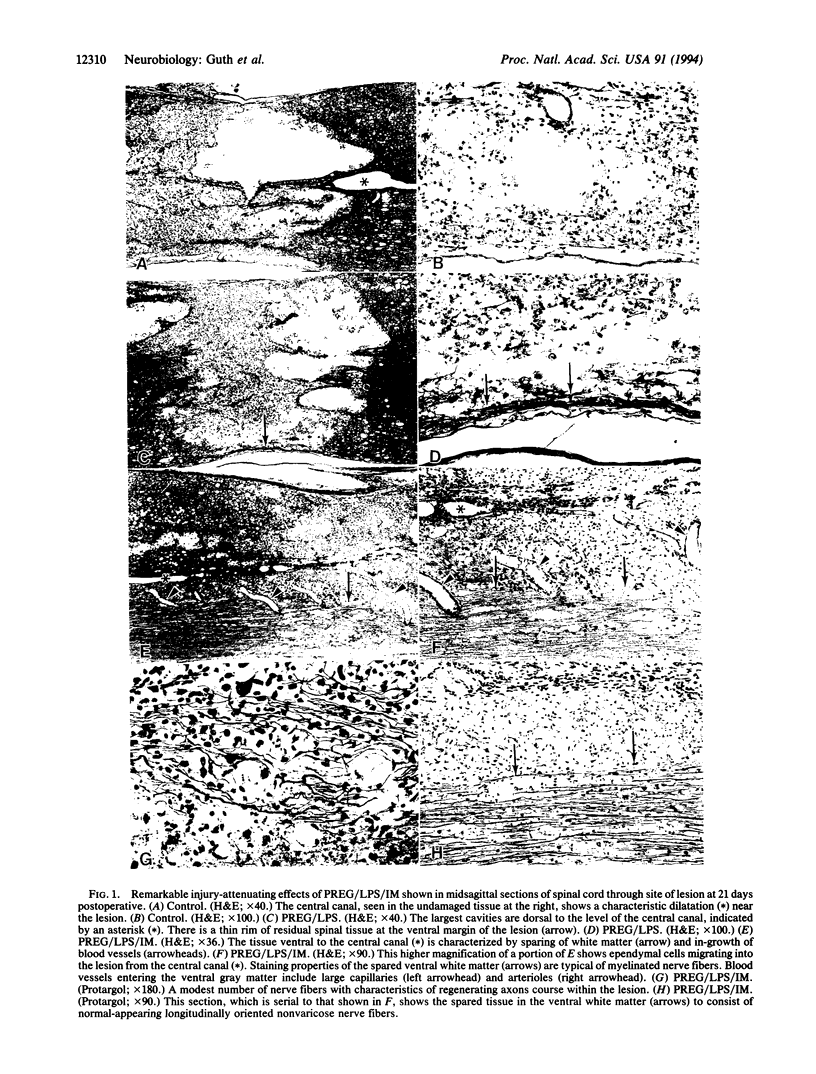

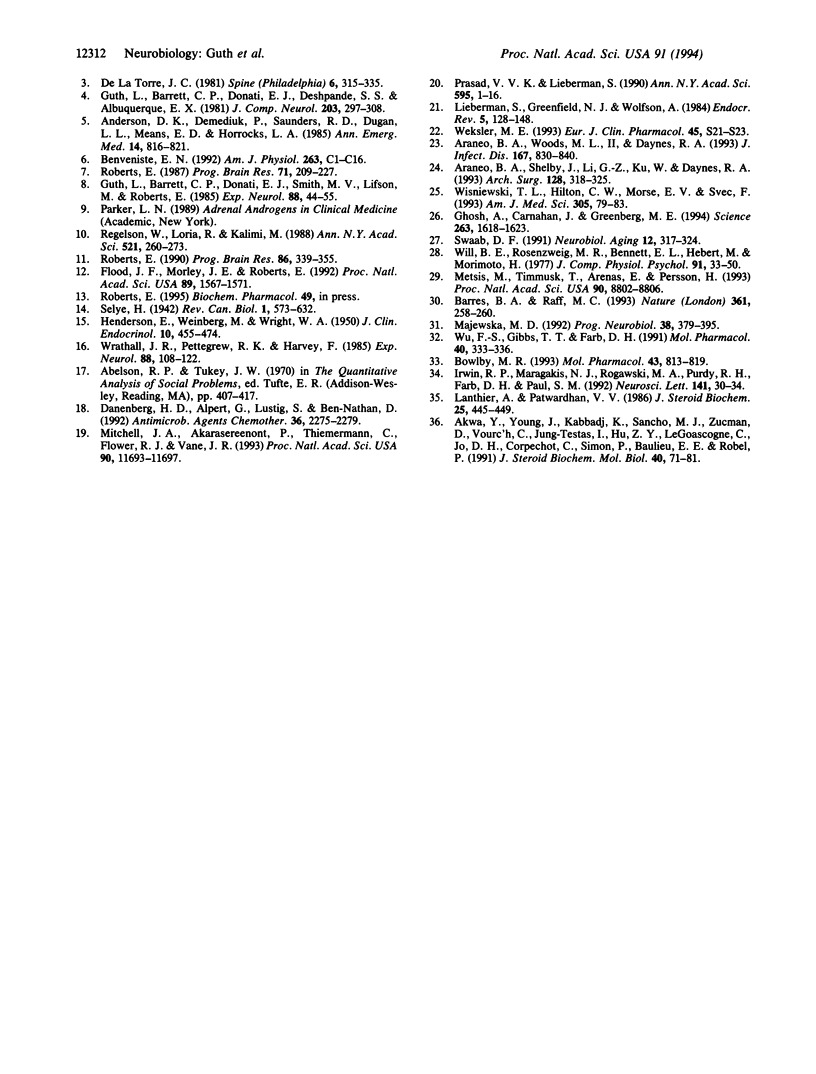
Images in this article
Selected References
These references are in PubMed. This may not be the complete list of references from this article.
- Akwa Y., Young J., Kabbadj K., Sancho M. J., Zucman D., Vourc'h C., Jung-Testas I., Hu Z. Y., Le Goascogne C., Jo D. H. Neurosteroids: biosynthesis, metabolism and function of pregnenolone and dehydroepiandrosterone in the brain. J Steroid Biochem Mol Biol. 1991;40(1-3):71–81. doi: 10.1016/0960-0760(91)90169-6. [DOI] [PubMed] [Google Scholar]
- Anderson D. K., Demediuk P., Saunders R. D., Dugan L. L., Means E. D., Horrocks L. A. Spinal cord injury and protection. Ann Emerg Med. 1985 Aug;14(8):816–821. doi: 10.1016/s0196-0644(85)80064-0. [DOI] [PubMed] [Google Scholar]
- Araneo B. A., Shelby J., Li G. Z., Ku W., Daynes R. A. Administration of dehydroepiandrosterone to burned mice preserves normal immunologic competence. Arch Surg. 1993 Mar;128(3):318–325. doi: 10.1001/archsurg.1993.01420150074014. [DOI] [PubMed] [Google Scholar]
- Araneo B. A., Woods M. L., 2nd, Daynes R. A. Reversal of the immunosenescent phenotype by dehydroepiandrosterone: hormone treatment provides an adjuvant effect on the immunization of aged mice with recombinant hepatitis B surface antigen. J Infect Dis. 1993 Apr;167(4):830–840. doi: 10.1093/infdis/167.4.830. [DOI] [PubMed] [Google Scholar]
- Balentine J. D. Pathology of experimental spinal cord trauma. I. The necrotic lesion as a function of vascular injury. Lab Invest. 1978 Sep;39(3):236–253. [PubMed] [Google Scholar]
- Barres B. A., Raff M. C. Proliferation of oligodendrocyte precursor cells depends on electrical activity in axons. Nature. 1993 Jan 21;361(6409):258–260. doi: 10.1038/361258a0. [DOI] [PubMed] [Google Scholar]
- Benveniste E. N. Inflammatory cytokines within the central nervous system: sources, function, and mechanism of action. Am J Physiol. 1992 Jul;263(1 Pt 1):C1–16. doi: 10.1152/ajpcell.1992.263.1.C1. [DOI] [PubMed] [Google Scholar]
- Bowlby M. R. Pregnenolone sulfate potentiation of N-methyl-D-aspartate receptor channels in hippocampal neurons. Mol Pharmacol. 1993 May;43(5):813–819. [PubMed] [Google Scholar]
- Danenberg H. D., Alpert G., Lustig S., Ben-Nathan D. Dehydroepiandrosterone protects mice from endotoxin toxicity and reduces tumor necrosis factor production. Antimicrob Agents Chemother. 1992 Oct;36(10):2275–2279. doi: 10.1128/aac.36.10.2275. [DOI] [PMC free article] [PubMed] [Google Scholar]
- Flood J. F., Morley J. E., Roberts E. Memory-enhancing effects in male mice of pregnenolone and steroids metabolically derived from it. Proc Natl Acad Sci U S A. 1992 Mar 1;89(5):1567–1571. doi: 10.1073/pnas.89.5.1567. [DOI] [PMC free article] [PubMed] [Google Scholar]
- Ghosh A., Carnahan J., Greenberg M. E. Requirement for BDNF in activity-dependent survival of cortical neurons. Science. 1994 Mar 18;263(5153):1618–1623. doi: 10.1126/science.7907431. [DOI] [PubMed] [Google Scholar]
- Guth L., Barrett C. P., Donati E. J., Deshpande S. S., Albuquerque E. X. Histopathological reactions an axonal regeneration in the transected spinal cord of Hibernating squirrels. J Comp Neurol. 1981 Dec 1;203(2):297–308. doi: 10.1002/cne.902030209. [DOI] [PubMed] [Google Scholar]
- Guth L., Barrett C. P., Donati E. J., Smith M. V., Lifson M., Roberts E. Enhancement of axonal growth into a spinal lesion by topical application of triethanolamine and cytosine arabinoside. Exp Neurol. 1985 Apr;88(1):44–55. doi: 10.1016/0014-4886(85)90112-8. [DOI] [PubMed] [Google Scholar]
- Guth L., Zhang Z., DiProspero N. A., Joubin K., Fitch M. T. Spinal cord injury in the rat: treatment with bacterial lipopolysaccharide and indomethacin enhances cellular repair and locomotor function. Exp Neurol. 1994 Mar;126(1):76–87. doi: 10.1006/exnr.1994.1043. [DOI] [PubMed] [Google Scholar]
- HENDERSON E., WEINBERG M., WRIGHT W. A. Pregnenolone. J Clin Endocrinol Metab. 1950 Apr;10(4):455–474. doi: 10.1210/jcem-10-4-455. [DOI] [PubMed] [Google Scholar]
- Irwin R. P., Maragakis N. J., Rogawski M. A., Purdy R. H., Farb D. H., Paul S. M. Pregnenolone sulfate augments NMDA receptor mediated increases in intracellular Ca2+ in cultured rat hippocampal neurons. Neurosci Lett. 1992 Jul 6;141(1):30–34. doi: 10.1016/0304-3940(92)90327-4. [DOI] [PubMed] [Google Scholar]
- Lanthier A., Patwardhan V. V. Sex steroids and 5-en-3 beta-hydroxysteroids in specific regions of the human brain and cranial nerves. J Steroid Biochem. 1986 Sep;25(3):445–449. doi: 10.1016/0022-4731(86)90259-1. [DOI] [PubMed] [Google Scholar]
- Lieberman S., Greenfield N. J., Wolfson A. A heuristic proposal for understanding steroidogenic processes. Endocr Rev. 1984 Winter;5(1):128–148. doi: 10.1210/edrv-5-1-128. [DOI] [PubMed] [Google Scholar]
- Majewska M. D. Neurosteroids: endogenous bimodal modulators of the GABAA receptor. Mechanism of action and physiological significance. Prog Neurobiol. 1992;38(4):379–395. doi: 10.1016/0301-0082(92)90025-a. [DOI] [PubMed] [Google Scholar]
- Metsis M., Timmusk T., Arenas E., Persson H. Differential usage of multiple brain-derived neurotrophic factor promoters in the rat brain following neuronal activation. Proc Natl Acad Sci U S A. 1993 Oct 1;90(19):8802–8806. doi: 10.1073/pnas.90.19.8802. [DOI] [PMC free article] [PubMed] [Google Scholar]
- Mitchell J. A., Akarasereenont P., Thiemermann C., Flower R. J., Vane J. R. Selectivity of nonsteroidal antiinflammatory drugs as inhibitors of constitutive and inducible cyclooxygenase. Proc Natl Acad Sci U S A. 1993 Dec 15;90(24):11693–11697. doi: 10.1073/pnas.90.24.11693. [DOI] [PMC free article] [PubMed] [Google Scholar]
- Prasad V. V., Lieberman S. Master lecture. Reconsidering some of the biosynthetic pathways leading to formation of C19-steroids. Ann N Y Acad Sci. 1990;595:1–16. doi: 10.1111/j.1749-6632.1990.tb34278.x. [DOI] [PubMed] [Google Scholar]
- Regelson W., Loria R., Kalimi M. Hormonal intervention: "buffer hormones" or "state dependency". The role of dehydroepiandrosterone (DHEA), thyroid hormone, estrogen and hypophysectomy in aging. Ann N Y Acad Sci. 1988;521:260–273. doi: 10.1111/j.1749-6632.1988.tb35284.x. [DOI] [PubMed] [Google Scholar]
- Roberts E. A systems approach to aging, Alzheimer's disease, and spinal cord regeneration. Prog Brain Res. 1990;86:339–355. doi: 10.1016/s0079-6123(08)63190-8. [DOI] [PubMed] [Google Scholar]
- Roberts E. A systems approach to nerve regeneration. Prog Brain Res. 1987;71:209–227. doi: 10.1016/s0079-6123(08)61826-9. [DOI] [PubMed] [Google Scholar]
- Swaab D. F. Brain aging and Alzheimer's disease, "wear and tear" versus "use it or lose it". Neurobiol Aging. 1991 Jul-Aug;12(4):317–324. doi: 10.1016/0197-4580(91)90008-8. [DOI] [PubMed] [Google Scholar]
- Weksler M. E. Immune senescence and adrenal steroids: immune dysregulation and the action of dehydroepiandrosterone (DHEA) in old animals. Eur J Clin Pharmacol. 1993;45 (Suppl 1):S21–S44. doi: 10.1007/BF01844199. [DOI] [PubMed] [Google Scholar]
- Will B. E., Rosenzweig M. R., Bennett E. L., Hebert M., Morimoto H. Relatively brief environmental enrichment aids recovery of learning capacity and alters brain measures after postweaning brain lesions in rats. J Comp Physiol Psychol. 1977 Feb;91(1):33–50. doi: 10.1037/h0077306. [DOI] [PubMed] [Google Scholar]
- Wisniewski T. L., Hilton C. W., Morse E. V., Svec F. The relationship of serum DHEA-S and cortisol levels to measures of immune function in human immunodeficiency virus-related illness. Am J Med Sci. 1993 Feb;305(2):79–83. doi: 10.1097/00000441-199302000-00003. [DOI] [PubMed] [Google Scholar]
- Wrathall J. R., Pettegrew R. K., Harvey F. Spinal cord contusion in the rat: production of graded, reproducible, injury groups. Exp Neurol. 1985 Apr;88(1):108–122. doi: 10.1016/0014-4886(85)90117-7. [DOI] [PubMed] [Google Scholar]
- Wu F. S., Gibbs T. T., Farb D. H. Pregnenolone sulfate: a positive allosteric modulator at the N-methyl-D-aspartate receptor. Mol Pharmacol. 1991 Sep;40(3):333–336. [PubMed] [Google Scholar]
- de la Torre J. C. Spinal cord injury. Review of basic and applied research. Spine (Phila Pa 1976) 1981 Jul-Aug;6(4):315–335. [PubMed] [Google Scholar]



